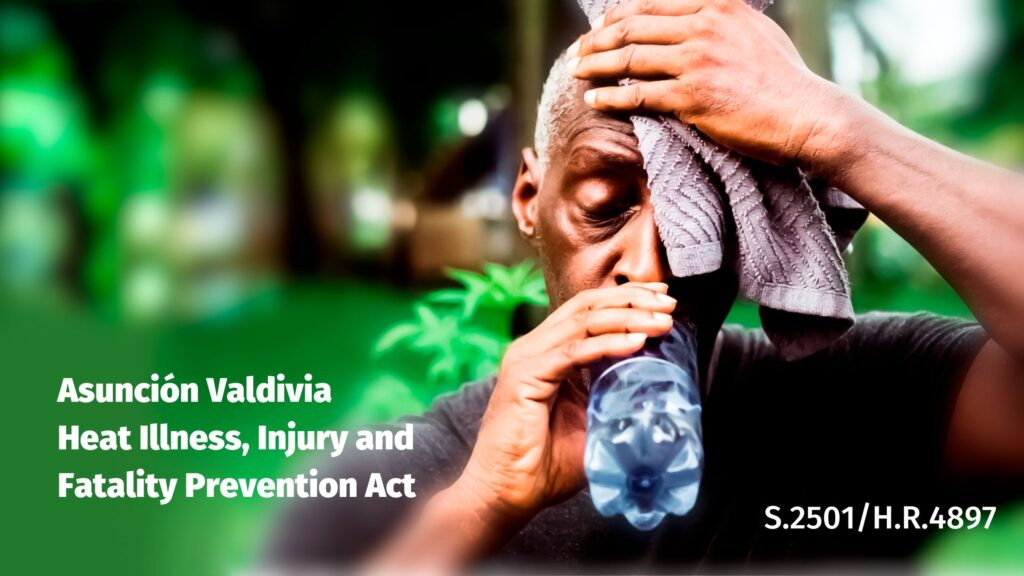Factsheet – Bill to Protect Workers from Heat Stress
Asuncíon Valdivia Heat Illness, Injury and Fatality Prevention Act
By Juley Fulcher
Factsheet – Worker Heat Protection Bill 8.28.2023
Protecting Workers from Heat-Related Illness, Injury and Death
Congress must direct the Occupational Safety and Health Administration (OSHA) to issue an interim heat standard to protect workers from excessive heat exposure.
IMPORTANT FACTS
- Heat is the leading weather-related killer, and it is becoming more dangerous, as 21 of the last 22 years were the hottest on record.[1] This year, 2023, will likely be the hottest yet,[2] and 2024 is expected to be even hotter.[3] Throughout the nation during the summer of 2023, we’ve seen more than 16,000 daily extreme high temperature records broken[4] and extraordinary heat waves lasting weeks at a time.[5]
- As much of the U.S. has been blanketed by smoke from wildfires in Canada this summer, it’s important to know that breathing wildfire smoke during extreme heat triples the chances a person will die from heat stress.[6]
- Heat exposure is responsible for as many as 2,000 worker fatalities in the U.S. each year.[7] Up to 170,000 workers in the U.S. are injured in heat stress related accidents annually.[8] There is a 1% increase in workplace injuries for every increase of 1° Celsius.[9]
- The failure of employers to implement simple heat safety measures costs the U.S. economy nearly $100 billion every year.[10]
- The lowest-paid 20% of workers suffer five times as many heat-related injuries as the highest-paid 20%.[11]
- Worker heat-stress tragedies disproportionately strike workers who are poor, Black or Brown.[12]
- There are many simple ways employers can mitigate heat stress in the workplace, like providing access to cool drinking water and adequate “cool down” breaks in a shaded or air-conditioned space.
- At least 50,000 injuries and illnesses could be avoided in the U.S. each year with an effective OSHA heat standard.[13]
Many occupations expose workers to dangerous heat stress risks, both indoors and outdoors. Examples of workers at particularly high risk are farm laborers, construction workers, utility workers, delivery drivers, first responders, refuse and recycling workers, oil rig workers and those who work in factories, warehouses, commercial laundries, restaurants, and bakeries.
WHAT CAN CONGRESS DO?
In 2021, OSHA began the process of creating a permanent heat standard. However, on average it takes OSHA seven to eight years to complete a final rule.[14] Workers can’t afford to wait.
Congress can empower OSHA to issue an interim standard that would protect workers until a final rule can be completed. It is essential that Congress takes this step. Helmed by Senators Sherrod Brown (OH), Alex Padilla (CA) and Catherine Cortez Masto (NV) and Representatives Judy Chu (CA-28), Raúl Grijalva (AZ-7), Alma Adams (NC-12), and Bobby Scott (VA-3), the Asuncíon Valdivia Heat Illness and Fatality Prevention Act (named for a California farmer who died working under extreme heat conditions) would require OSHA to put an interim heat rule in place until the final heat rule is issued.
We call upon members of Congress to co-sponsor the Asuncíon Valdivia Heat Illness, Injury and Fatality Prevention Act (S.2501/H.R.4897) and help get it to a floor vote.
For additional information, contact Juley Fulcher (jfulcher@citizen.org), Worker Health and Safety Advocate in Public Citizen’s Congress Watch Division.
[1] Annual 2022 Global Climate Report, NOAA national centers for environmental information (July, 2023), https://bit.ly/3rxP03n.
[2] Alice Hill, The Age of Climate Disaster is Here: Preparing for a Future of Extreme Weather, Foreign Affairs (Aug. 25, 2023), https://fam.ag/45qUOuu.
[3] Andrew Freedman, America’s Cruel Summer, Axios (July 8, 2023), https://bit.ly/3OmsVh9.
[4] Data Tools: Daily Weather Records, NOAA (viewed on Aug., 24 2023), https://www.ncdc.noaa.gov/cdo-web/datatools/records.
[5] Brian Bushard, Phoenix Faces Hottest Day in Six Years: Here’s Where Else Records Could Fall, Forbes (July 20, 2023), https://bit.ly/3Y4xBLN.
[6] Md Mostafijur Rahman, Rob McConnell, Hannah Schlaerth, Joseph Ko, Sam Silva, Frederick W. Lurmann, Lawrence Palinkas, Jill Johnston, Michael Hurlburt, Hao Yin, George Ban-Weiss and Erika Garcia, The Effects of Coexposure to Extremes of Heat and Particulate Air Pollution on Mortality in California: Implications for Climate Change, American Journal of respiratory and critical care medicine, 206:9 (June 21, 2022), https://doi.org/10.1164/rccm.202204-0657OC.
[7] Juley Fulcher, Boiling Point: OSHA Must Act Immediately to Protect Workers From Deadly Temperatures, Public Citizen (June, 2022), https://bit.ly/3tfFlff.
[8] Id.
[9] Syeda Hira Fatima, Paul Rothmore, Lynne C. Giles, Blesson M. Varghese and Peng Bi, Extreme Heat and Occupational Injuries in Different Climate Zones: A Systematic Review and Meta-analysis of Epidemiological Evidence, 148 Environment International 106384 (Mar., 2021), https://bit.ly/3jGUEcL.
[10] Luke A. Parsons, Yuta J. Masuda, Timm Kroeger, Drew Shindell, Nicholas H. Wolff and June T. Spector, Global Labor Loss Due to Humid Heat Exposure Underestimated for Outdoor Workers,17(1) Environmental Research Letters 014050 (2022), https://bit.ly/3DXvrWn.
[11] R. Jisung Park, Nora Pankratz & A. Patrick Behrer, Temperature, Workplace Safety, and Labor Market Inequality, IZA Institute of Labor Economics DP No. 14560 3 (July, 2021), https://bit.ly/2V3WriI.
[12] See, Fulcher, Boiling Point (2022), https://bit.ly/3tfFlff
[13] Fulcher, Boiling Point (2022), https://bit.ly/3tfFlff.
[14] See, e.g., Congressional Research Service, Cost Benefit Analysis in Federal Agency Rulemaking (Mar. 8, 2022 ), https://bit.ly/3RrAOjG.
